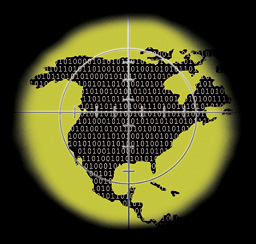 |
 |
 |
 Technology News | September 2007 Technology News | September 2007  
New Focus on Cyber-Terrorism
 Les Blumenthal - McClatchy Newspapers Les Blumenthal - McClatchy Newspapers
go to original


| | Using the web to spread terror and raise money |
A report showed up on a password-protected terrorist Web site in the summer of 2006 detailing the supposed susceptibility of the Army's Stryker vehicles to rocket-propelled grenades.

The terrorists found it on a think tank's Web site, downloaded it to their own site and urged fellow mujahadeen to study it and use what they learned in attacking the U.S. combat vehicles in Iraq.

Though the report had been discredited, its posting on a jihadist Web site shows how dogged terrorists have become in using the Internet.

From "Jihad University" to "Terrorists 007" to 5,000 or more other sites, terrorists are using cyber-space to spread their propaganda, recruit members, raise money, offer training and instruction, and conduct operational planning. It's become a vital front in the war on terror, and some lawmakers on Capitol Hill and independent experts feel the United States could be doing a better job of countering the threat.

"They (terrorists) are very sophisticated," Rep. Adam Smith, D-Wash., chairman of the House Armed Services terrorism subcommittee, said recently. "It has become a crucial battleground in this struggle, and if we do not treat it as such, we will not defeat these terrorists."

An alphabet soup of U.S. intelligence agencies - the NSA, the CIA, the FBI, the DIA - along with the departments of Defense, State and Homeland Security and the private sector, are monitoring terrorists' Web sites.

"It's not like we aren't looking at these sites," Smith said. "But we need better coordination, processing of what we find. It's a major concern."

Others agree.

"The government efforts are inadequate," said Bruce Hoffman, a professor in the Securities Studies Program at Georgetown University. He suggests the private sector is doing a better job. "Our enemies have embraced the Internet. We have to ask how closely the government is monitoring it."

Much of what the government intelligence community is doing is classified. Few details are available.

At the Department of Homeland Security, the focus has been on protecting government and private Web sites from cyber-attacks by terrorists and other hackers who want to view classified information or crash the sites with waves of e-mail.

"There are intrusions happening every day," said Russ Knocke, a Homeland Security spokesman. "There is no evidence of activity tied to the terror network. But it remains something we are concerned about."

Smith also is guarded in what he can say without breaching national security. Smith said the U.S. government has launched an effort to counter some of the propaganda that terrorists offer in Internet chat rooms, and on message boards, blogs and other Web sites. He says the government programs use some "fairly cool stuff" he can't talk about publicly.

The Internet threat is wide-ranging, complicated and not easy to contain.

Some sites include veritable libraries of videos showing terrorist attacks on U.S. forces in Iraq. Elsewhere, there are realistic video games based on attacking U.S. forces in Iraq or Israelis featuring figures like "Juba the sniper." Other sites, which show videos of beheadings, have been known to crash because so many people are trying to get online.

"They are enormously useful for providing motivation," said Daniel Benjamin of the sites. He is a senior fellow at the Brookings Institution and a former director of counterterrorism for the National Security Council during Bill Clinton's presidency.

The sites can contain instructions on how to use small arms, mortars and rockets, how to build bombs and how to train to become a sniper.

Some analysts say the training and instructions now offered on the Internet have essentially replaced the terrorist training camps established in Afghanistan and elsewhere in the 1980s and 1990s.

The sites also can contain clues of what terrorists might be planning, Benjamin said. He noted that a document, written in Arabic and found by Norwegian intelligence analysts, suggested Spain was the weakest link in the U.S.-led Iraq coalition and that violent action could undermine Spanish support for the war. The document supposedly was posted online before the March 11, 2004, bombing attacks in Madrid.

The terrorists can share tactics, techniques and procedures using off-the-shelf encryption. Some will embed messages or operational instructions in seemingly harmless pictures or audio files in a high-tech game of cat-and-mouse known as steganography.

"It's network-centric warfare and we gave them the tools," said Loren Thompson of the Lexington Institute, a public-policy research group that focuses in military issues. "There is no limit how they can use the Internet. A terrorist can walk into an Internet cafe in Islamabad and within a minute communicate with 10,000 people." | 
 | |
 |



